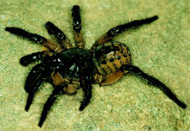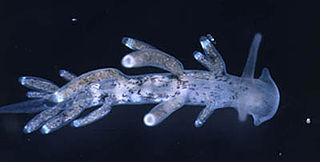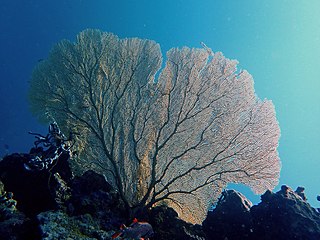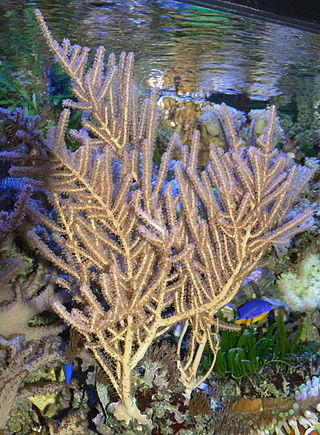
Rhizobium is a genus of Gram-negative soil bacteria that fix nitrogen. Rhizobium species form an endosymbiotic nitrogen-fixing association with roots of (primarily) legumes and other flowering plants.

Octocorallia is a class of Anthozoa comprising over 3,000 species of marine organisms formed of colonial polyps with 8-fold symmetry. It includes the blue coral, soft corals, sea pens, and gorgonians within three orders: Alcyonacea, Helioporacea, and Pennatulacea. These organisms have an internal skeleton secreted by mesoglea and polyps with eight tentacles and eight mesentaries. As with all Cnidarians these organisms have a complex life cycle including a motile phase when they are considered plankton and later characteristic sessile phase.

Macrothele is a genus of mygalomorph spiders in the family Macrothelidae, and was first described by A. Ausserer in 1871. Most of the species in the genus occur in Asia, from India to Japan, and Java, with five found in Africa, and two in Europe. The name is derived from Ancient Greek μακρός ("makro-"), meaning "big", and θηλή ("thele"), referring to the spinnerets.

The particolored flying squirrel is a species of rodent in the family Sciuridae. It is found in Bangladesh, Bhutan, Cambodia, China, India, Laos, Myanmar, Nepal, Thailand, and Vietnam. Its natural habitat is subtropical or tropical dry forests. It is threatened by habitat loss.

Liphistius is a genus of basal trapdoor spiders in the family Liphistiidae. They are found in Japan, China, and Southeast Asia.

Daxiatitan is a genus of sauropod dinosaur known from the Lower Cretaceous of Gansu, China. Its type and only species is Daxiatitan binglingi. It is known from a single partial skeleton consisting of most of the neck and back vertebrae, two tail vertebrae, a shoulder blade, and a thigh bone. At the time of its discovery in 2008, Daxiatitan was regarded as potentially the largest known dinosaur from China.

Keratoisis is a genus of deep-sea bamboo coral in the family Isididae, containing the following species:

Xianshanosaurus is a genus of sauropod dinosaur from the Early Cretaceous (Aptian-Albian) of the Ruyang Basin in Henan Province, China. Its type and only species is Xianshanosaurus shijiagouensis. It was described in 2009 by a team of paleontologists led by Lü Junchang. Xianshanosaurus may be a titanosaur, and Daxiatitan may be its closest relative, but its evolutionary relationships remain controversial.

Tenellia is a genus of sea slugs, aeolid nudibranchs, marine gastropod mollusks in the family Trinchesiidae.

Alcyoniidae is a family of leathery or soft corals in the phylum Cnidaria.
Songthela is a spider genus in the family Heptathelidae, with species found in China and Vietnam.

Scleraxonia is a suborder of corals, a member of the phylum Cnidaria.

Anthothelidae is a family of corals, a member of the phylum Cnidaria.

Holaxonia is a suborder of soft corals, a member of the phylum Cnidaria. Members of this suborder are sometimes known as gorgonians and include the sea blades, the sea fans, the sea rods and the sea whips. These soft corals are colonial, sessile organisms and are generally tree-like in structure. They do not have a hard skeleton composed of calcium carbonate but have a firm but pliable, central axial skeleton composed of a fibrous protein called gorgonin embedded in a tissue matrix, the coenenchyme. In some genera this is permeated with a calcareous substance in the form of fused spicules. Members of this suborder are characterized by having an unspiculated axis and often a soft, chambered central core. The polyps have eight-fold symmetry and in many species, especially in the families Gorgoniidae and Plexauridae, contain symbiotic photosynthetic algae called zooxanthellae. These soft corals are popular in salt water aquaria.

Gorgoniidae is a family of soft corals, a member of the subclass Octocorallia in the phylum Cnidaria. Nearly all the genera and species are native to the east and west coasts of America.

Eleutherobia is a genus of soft corals in the family Alcyoniidae.

Clavulariidae is a family of soft corals in the suborder Stolonifera. Colonies in this family consist of separate retractable polyps growing from a horizontal, encrusting stolon or basal membrane. The tissues are stiffened by sclerites.

Qiongthela is a genus of spiders in the family Heptathelidae. As of 2021, it contains 14 species.

Hicksonella is a genus of corals belonging to the family Gorgoniidae.

Boulenophrys is a genus of frogs in the family Megophryidae. They occur in the China, Mainland Southeast Asia and Northeast India. It had been placed variously as a subgenus or synonymy of Megophrys. Dubois, Ohler and Pyron first recognized that Panophrys is preoccupied and employed Boulenophrys as the generic name rather than Tianophrys under the Principle of First Revisor.


















